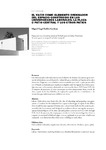El vacío como elemento ordenador del espacio construido en las Universidades Laborales: la plaza o patio central y losotros patios

View/
Use this link to cite
http://hdl.handle.net/2183/14372Collections
Metadata
Show full item recordTitle
El vacío como elemento ordenador del espacio construido en las Universidades Laborales: la plaza o patio central y losotros patiosAlternative Title(s)
Empty space as a structuring element of the built spaces in Labour Universities: the main square or courtyard and other courtyardsAuthor(s)
Date
2014Citation
Boletín Académico, 2014, 4: 23-32. ISNN 2173-6723
Abstract
[Resumen] Las Universidades Laborales nacen con el objetivo de formar a las nuevas generaciones
de trabajadores para el desarrollo industrial que se iniciaba en España en los años
cincuenta. Llegarían a ser veintiún centros repartidos por todo el país, promovidos
por el Estado y diseñados por arquitectos elegidos entre las fi guras de máximo prestigio
nacional del momento, abarcando su construcción desde 1945 hasta 1976. En
el conjunto de proyectos, el vacío destaca por su valor estructurante, bien a modo de
plaza o patio de bordes defi nidos, de explanada o patio abierto o semiabierto, o de
intersticios que relacionan unos edifi cios con otros. [Abstract]
Labour Universities were born with the aim of educating and preparing new generations
of workers for the industrial development that began in Spain in the fi fties.
Th ey would become a group of twenty-one Centers located all over the country, promoted
by the Government and designed by architects chosen among the most prestigious
national fi gures of the time, spreading their construction from 1945 through
1976. In all the projects, the empty space stands out for its structuring value either as
a square or courtyard of defi ned edges, or as an esplanade or as an open or half-open
courtyard, or as interstices that relate some buildings to each other.
Keywords
Universidades laborales
Arquitectura docente
Movimiento moderno
Patio
Plaza
Labour universities
Teaching architecture
Modern movement
Courtyard
Square
Arquitectura docente
Movimiento moderno
Patio
Plaza
Labour universities
Teaching architecture
Modern movement
Courtyard
Square
ISSN
2173-6723





